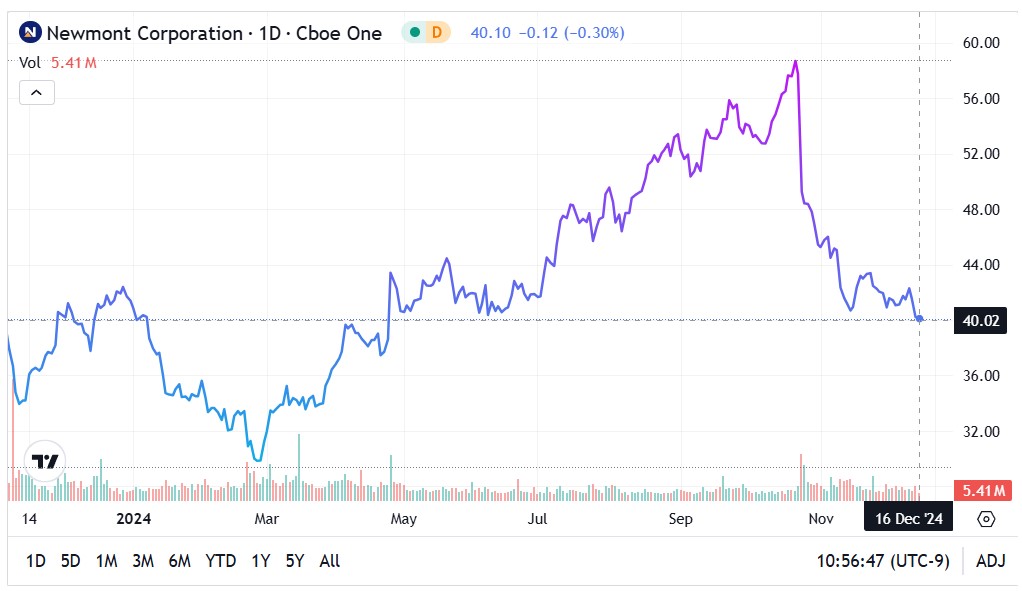Zinger Key Points
- Germany’s governmental coalition collapsed following recent political upheaval in France.
- The geopolitical mess may open a safe-haven trade with gold proxy Newmont’s call options.
- Get real-time earnings alerts before the market moves and access expert analysis that uncovers hidden opportunities in the post-earnings chaos.
In times of geopolitical uncertainty, investors often turn to stable assets like Newmont Corporation NEM to protect their wealth.
Just recently, AFP reported that German Chancellor Olaf Scholz lost a confidence vote, essentially marking the conclusion of his embattled administration. This political upheaval, coupled with the French government’s collapse earlier this month, has set the stage for safe-haven speculation.
Billed as the world’s leading gold company, NEM stock represents a proxy for the precious metal. Historically, investors have viewed gold as the ultimate form of wealth preservation.
Another fundamental catalyst for higher precious metal prices is inflation. Analysts widely expect the Federal Reserve to announce a 25-basis-point rate cut on Wednesday. Naturally, this anticipated action has reignited inflation concerns, which, all other things being equal, should be positive for gold.

Finally, NEM stock appears to be sitting on a psychologically significant technical support line at $40 per share. While the security has been volatile since late October, the negative velocity has slowed in recent sessions. Therefore, intrepid investors may look to NEM as a bounce-back candidate.
Laying the Framework of the Bull Call Spread
Of course, the easiest mechanism to speculate on Newmont stock is to buy the company's shares in the open market. However, this approach lacks leverage. Currently, the gold producer carries a market capitalization of nearly $46 billion. Simply put, there's likely not going to be much movement in its share price.
Subsequently, many retail traders turn to buying call options. According to data from the New York Stock Exchange, these market participants tend to buy low-priced options; that is, far out-the-money derivatives that have little chance of being net profitable.
A better approach may be to deploy the bull call spread. Here, a trader buys a call for a particular options chain. However, the distinction between a straight call purchase and a bull call spread is that the trader simultaneously sells a call at a higher strike price (for the same expiration date).
To be fair, the structure of the trade caps the maximum reward (or payout) at the point represented by the higher short call strike. However, the benefit is twofold. First, the trader's net bullish position is discounted because the gross credit received from the short call helps partially offset the debit paid for the long call. Second, the threshold to profitability (i.e. the breakeven point) is effectively lowered by the aforementioned credit.
Therefore, the bull call spread allows traders to consider more probabilistically favorable transactions rather than taking longshot odds (such as "cheap" far OTM options).
Calculating an Ideal Spread for NEM Stock
With a popular security like Newmont stock, there are several bull call spreads to choose from. Ideally, though, the name of the game is to target spreads that are likely to be successful while also providing adequate payouts.
To better understand the market's anticipated move, traders can deploy a stochastic analysis to calculate the projected share price movement. This process involves multiplying the stock price with its option chain's implied volatility (IV) and time decay adjustment (or the square root of the calendar days to expiration divided by 365 days).
For example, the Dec. 27 options chain expires in 11 calendar days and features an average IV of 28.75%. Assuming a share price of $40.05, the product of the three metrics comes out to just under $2. In other words, the market anticipates, at most, NEM stock to rise to $42.05 or, at worst, fall to $38.05 by Dec. 27.
A compelling idea within this options chain may be to consider the 39/41 bull call spread (buy the $39 call, sell the $41 call). At time of writing, the net debit paid comes out to $110 (which is also the most that can be lost in the trade). Should the trade be fully successful — which would involve NEM stock reaching $41 or higher — the reward would be $90 or a nearly 82% payout.
Read Next:
Photo: Shutterstock
© 2025 Benzinga.com. Benzinga does not provide investment advice. All rights reserved.
Trade confidently with insights and alerts from analyst ratings, free reports and breaking news that affects the stocks you care about.